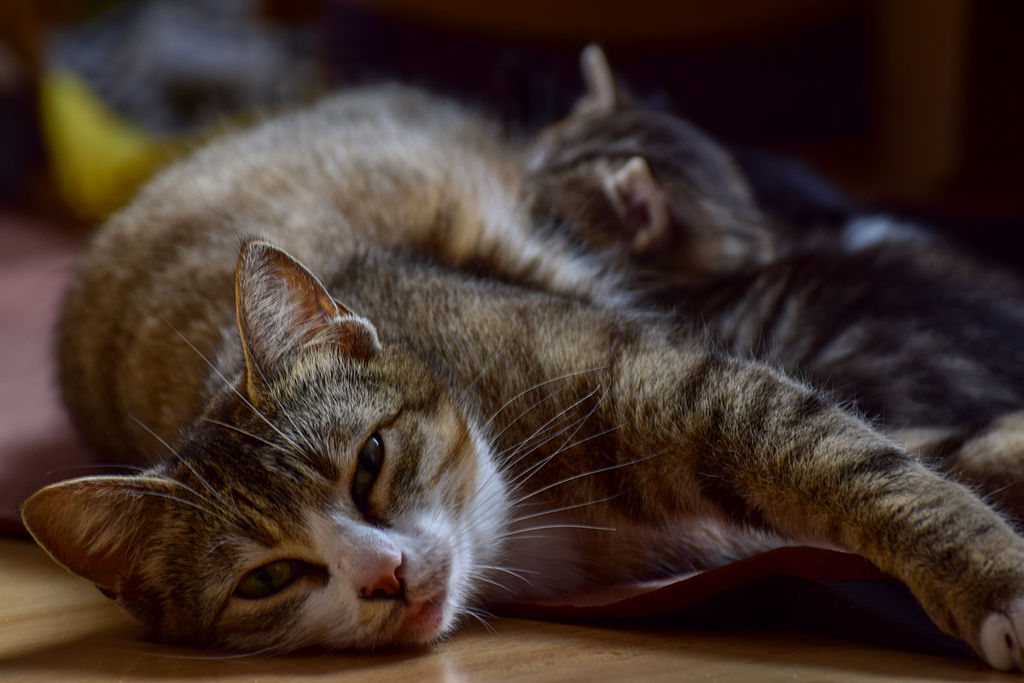It’s an exhilarating time when your household is expecting a new litter of kittens. The average cat’s pregnancy lasts for 64 to 67 days, or approximately 9 weeks. But how can you tell when your cat is going into labor? Here are five signs to help you anticipate this special moment.
Mammary Glands Will Increase in Size
During the final week of pregnancy, your cat’s mammary glands will increase in size. These glands are arranged in two parallel rows running along the outside body wall, extending from the groin area up to the underside of her chest. Most cats have four pairs of mammary glands. About two days before giving birth, your cat will start to produce milk. You may notice cream-colored secretions coming out of her nipples, which she might lick off or allow to dry up, resulting in small whitish scabs. Each nipple has its own unique smell, which kittens use to attach themselves to the same nipple repeatedly.
Nesting Behavior Will Begin
Similar to humans, your cat may start nesting behavior. You can assist your cat during this time by placing the nesting box in a quiet, warm room that is free from drafts. It’s crucial to ensure that the location of the box is off-limits to other pets and children. Encourage your cat to sleep inside the box as soon as you notice any nesting behavior.
Temperature Will Fall
A cat’s normal temperature ranges between 37.7º to 39.1ºC (100º to 102.5ºF). However, one to two days before giving birth, her temperature will drop to 37.2ºC (99ºF). While taking her temperature in the armpit is an option, there are usually enough other signs that labor is starting, so measuring her temperature may not be necessary.
Behavior Changes
Your cat will exhibit changes in behavior during the final week of pregnancy. She may become reclusive, hiding out in a secluded place in the house. Alternatively, she might become extremely affectionate, especially if she has a close relationship with one particular caregiver. Affectionate cats will want their caregivers close by, displaying clinginess while also feeling restless.
Decrease in Appetite
Expect a significant decrease in your cat’s appetite. This will be noticeable since most pregnant cats display an increased appetite during the final weeks of pregnancy. The decrease in appetite can be caused by the weight of the kittens pushing against their mother’s stomach or may simply be a symptom of general anxiety.
Licking, Pacing, Howling, and Chirping
You may observe your cat frequently licking her genitalia, as there is a discharge from her vulva a few hours before birth. Your cat’s water will break during this time, and she may exhibit pacing, restlessness, and howling, meowing, or chirping.
All of the signs mentioned above are good indicators that your cat is in labor. However, it’s always best to contact a veterinarian for further advice and guidance.
Frequently Asked Questions
Q: How long does a cat’s pregnancy typically last?
A: A cat’s pregnancy usually lasts for 64 to 67 days, or approximately 9 weeks.
Q: When does a cat’s temperature drop before giving birth?
A: A cat’s temperature typically drops one to two days before she gives birth.
Q: Why does a cat’s appetite decrease before labor?
A: A decrease in appetite can be caused by the weight of the kittens pressing against their mother’s stomach or by general anxiety.
Q: What are the signs that a cat is about to give birth?
A: Some signs include an increase in mammary gland size, nesting behavior, a decrease in appetite, behavior changes, and licking, pacing, howling, or chirping.
Conclusion
Anticipating your cat’s labor can be an exciting and nerve-wracking experience. By recognizing the signs discussed above, you can prepare for the arrival of adorable new kittens. Remember to consult with a veterinarian for personalized guidance during this special time.
For more informative articles and expert advice on pet care, visit Pawsoha!
